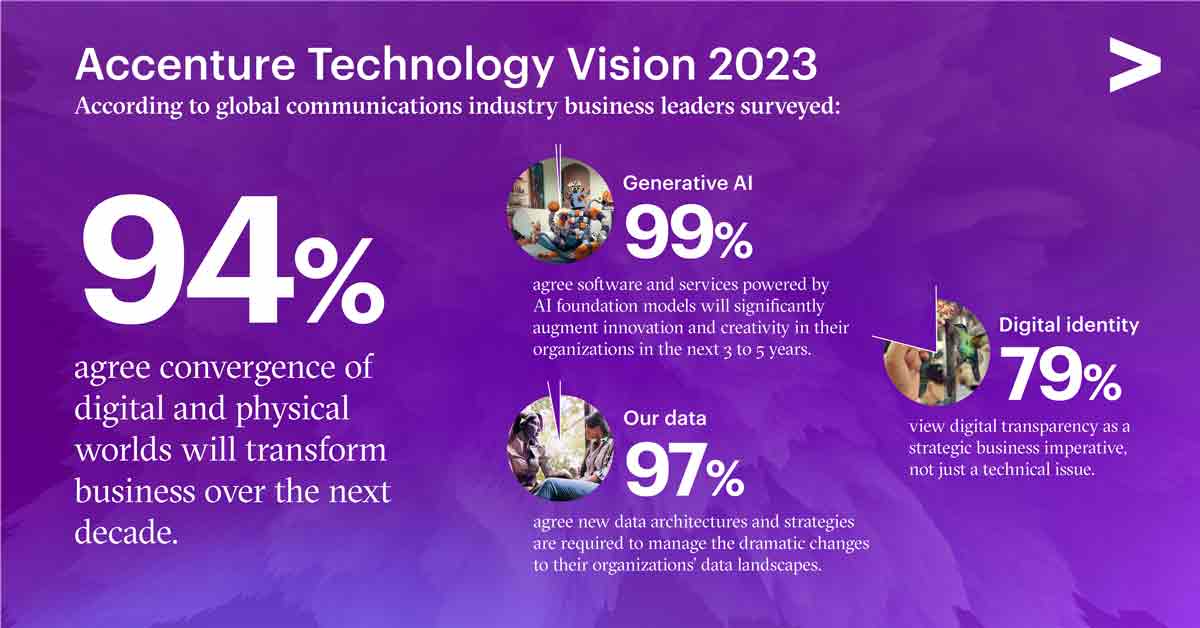
Moving into the second half of 2023, there are several converging technology trends that are helping to collapse the distance between our digital and physical worlds. These include generative artificial intelligence (AI), data transparency and digital identity, among others. These trends are poised to have a huge impact on the communications industry, requiring significant investments in technology, data, and people. However, in order to tap into the power of these technologies, communications leaders must first improve their digital cores, and in doing so create new pathways for growth. This is a once-in-a-generation opportunity, and communications companies have the chance to get it right the from the start.
To understand the impact of these trends, Accenture recently conducted a survey of 4,777 C-level executives and directors across 25 industries. Ninety-four percent of communications executives agreed that the convergence of digital and physical worlds over the next decade will transform their industry. And 99% agreed that investments in emerging technologies will help their organizations remain resilient on the global stage. While the full results of this survey can be found in its Technology Vision 2023 report below are some insights into the trends.
Generative AI
The introduction of pre-trained foundational models with remarkable task adaptability can revolutionize how and where communications providers use AI. While the lack of training data has been a major issue for companies trying to leverage AI in their organizations, these pre-trained foundation models solve this limitation. According to the survey results:
- 99% of communications executives agreed that software and services powered by AI foundation models will significantly augment innovation and creativity in their organizations in the next 3 to 5 years.
- 59% cited process automation and 54% cited information/data analysis as the areas they plan to experiment with AI foundational models in the next 3 to 5 years.
- 64% expect better customer experiences, and 61% expect accelerated innovation to be two major benefits from the use of AI foundation models.
- 98% agreed that advancements in generative AI such as GPT-3 are ushering in a new era of enterprise intelligence.
Communications leaders should consider experimenting with, and potentially deploying generative AI within their businesses to improve productivity and unlock trapped value. They should also take steps to build a talent pipeline with the skills to take foundation models and adapt them to business needs. Integrating them into applications will become increasingly important.
A perfect example is Vodafone, which in recent years started to transition from being a Telco to a technology company. In January 2022, the company launched its AI Booster Programme, a simple and accessible platform that can be used to build machine learning solutions using a variety of different frameworks. This was a complete change from their normal business model, but they took the right steps such as hiring software, machine learning, data and platform engineers to make sure they had the right expertise.
Digital identity
Today’s world is being held back by old models of identity. This requires the industry to undergo a physical-digital convergence where people and things have identity that can traverse both sides. This digital identity is going to be at the core of the next wave of business disruption fueled by digital-physical convergence. According to the survey:
- 79% of communication executives view digital transparency as a strategic business imperative, not just a technical issue and 83% agree changes constricting third-party tracking data are impacting their organization’s customer engagement
- 76% believe that issues with authenticating customers’ identity are negatively impacting their bottom line
- 87% report their organizations’ preferred strategy leans toward centralized, and 62% say Partnership-led solutions, to address the challenges faced by the lack of standardized digital identity
- 93% agree their organizations are innovating around digital identity via tokenization
Telecom vendors have the potential to play a unique and foundational role, especially in the world of decentralized identity and getting into newer areas like trusted identity and access management. This could range from e-signatures to identifications applications, games or the metaverse.
Data transparency
AI cannot reach its full potential until companies figure out how to fully leverage their data. They need to break down today’s data silos and modernize their data foundations so that they can be deliver better experiences to both their partners and customers. They key here is building trust. And communications executives agree:
- 92% think data is becoming a key competitive differentiator within organizations and across industries.
- 58% of communications executives report greater trust with customers, and 57% report accelerated innovation as the leading benefits of increased data transparency for their organizations.
- 97% of communications executives agree new data architectures and strategies are required to manage the dramatic changes to their organizations’ data landscapes.
- 98% of communications executives agree emerging data management approaches including Data Fabric and Data Mesh, will become critical in optimizing their organizations’ value chains.
Turning transparency into a strategic advantage will be the most valuable resource for enterprises in the future.
Getting it right the first time
The exponential change stemming from these rapidly converging technology trends will transform how we all do business, and communications companies have an opportunity to unleash new business value. The next wave of business transformation will enable both a shared reality that seamlessly converges the physical lives we’ve been leading with the digital lives we’ve been rapidly expanding. As those two worlds converge, there will be opportunities for meaningful growth in the communications industry beyond connectivity. They just need to be ready to ride the wave when it comes.



















